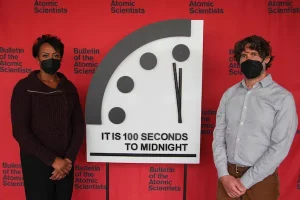
Suzet McKinney, member of the Bulletin of the Atomic Scientists’ Science and Security Board (SASB), and Daniel Holz, 2022 co-chair of the Bulletin’s SASB, reveal the 2022 time on the Doomsday Clock. Photo courtesy Thomas Gaulkin/Bulletin of the Atomic Scientists.
Before the war in Ukraine and Putin’s invasion, scientists at the Bulletin of Atomic Scientists and caretakers of the Doomsday Clock–observing the deterioration of affairs between the United States and Russia–sensed an impending disaster and moved the doomsday clock to a hundred seconds to midnight in 2021 and in January 2022, the closest it had ever been to midnight.
The clock, described by the Bulletin as “a design that warns the public about how close we are to destroying our world with dangerous technologies of our own,” was created in 1947 around nuclear issues. Over time it began highlighting other existential threats like climate change.
There are several parameters for making the doomsday prediction. In the case of the Russia-Ukraine war, the deterioration of relationships between the United States and Russia, the two countries controlling 90 percent of the world’s nuclear arsenal, and the collapse of the New Start Agreement. There are now very few restraints left around nuclear weapons.
Yet, do the people in power care about the Doomsday Clock or does it just have the cinematic effect of a giant alarm clock, like London’s Big Ben? Will it ever get to midnight? When the clock rings a few 100 seconds to midnight do the world powers care at all? These are questions asked by many of those paying attention to the world today, such as my radio audience in Lagos, Nigeria.
Rachel Bronson, president and CEO of the Bulletin of Atomic Scientists, gives us answers.
She says it is definitively cinematic, but in this way, it achieves its purpose. Every year the clock is announced, the news cycle stops for a moment and redirects to these important topics that are really hard to get in the news, but very essential for the continuation of humanity. If for one day a year the world can take a moment to talk about issues, such as climate change or nuclear weapons, that is a job well done. It’s also a job well done if they can get media audiences around the world to think about what nuclear weapons are, how many there are, why they are still of interest, and if it really is getting more dangerous, she says
Do leaders in power take it seriously? Yes and no. According to Bronson, it provides a sort of entryway to talk about these complicated issues made more complicated to keep the public out of the discussion. Politicians can use the timely prediction of the clock and the organization’s report published alongside it as a reference to provide perspectives on these existential issues.
The Doomsday Clock prompts scientists to ask if these predictions are alarmist or necessary. We should all ask these questions about the clock and the existential crises it warns us about. If the essence is to provoke conversation, we must have these conversations, before it is too late and novelty becomes a disaster.
What then is midnight? It is the end of humanity as we know it. Period.



